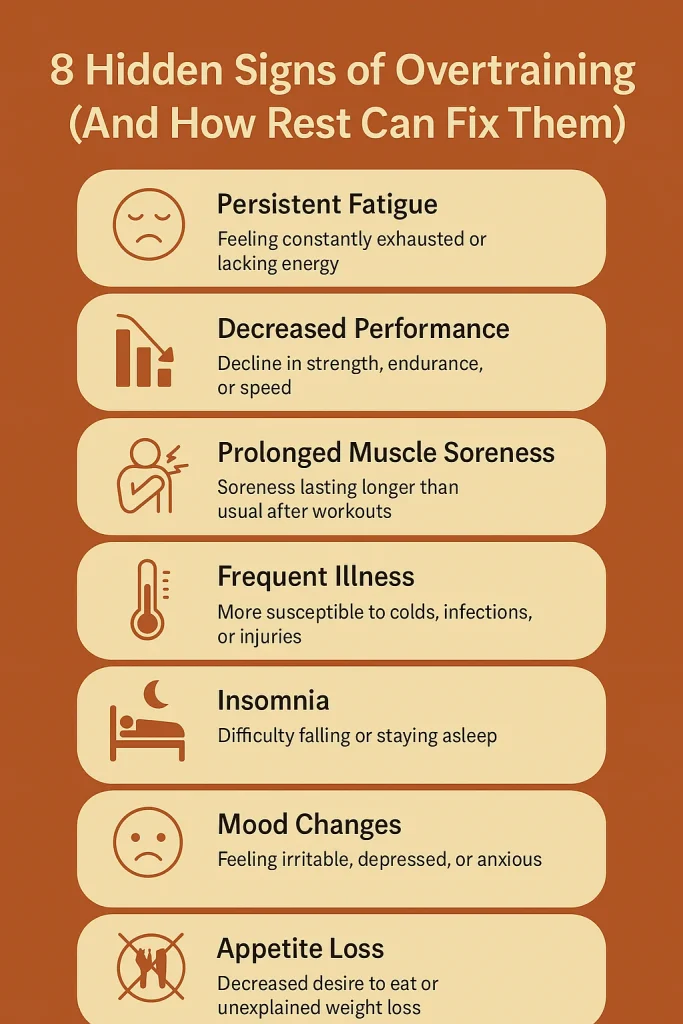8 Hidden Signs of Overtraining (And How Rest Can Fix Them)
Feeling stuck in progress? Uncover signs of overtraining and find out how smarter rest can unlock better result now!

This article is part of a series. Check them out all!
- Heart Rate Zones
- Energy Production: Fueling the Body
- Why Does Exercise Retain Water?
- All About Metabolism
- How Anabolism and Catabolism Shape a Stronger, Leaner Body!
- How to Build Muscle while Losing Fat – Body Recomposition
- What are the Requirements of Muscle Growth?
- How to Start Training to Build Muscles Optimally
- Sets & Reps
- The Body’s Fuel Sources
Are rest days truly necessary when following a consistent workout routine? The short answer: yes. The details behind this necessity, including the benefits and strategies for maximizing muscle growth during recovery periods, are worth a closer look.
In fitness culture, a persistent myth continues to circulate — the notion of “Team No Days Off.” However, this idea lacks scientific support. Rather than glorifying non-stop training, the focus must shift to a fundamental yet often underestimated factor: rest.
Rest days are not a setback but an integral part of the training cycle. Understanding how to approach them, avoid common mistakes, and implement effective strategies can lead to long-term progress and improved performance.

Is Time Off from Training Really Necessary?
Before diving into the reasons why rest days are essential, a clear understanding of what defines a rest day is needed. Consider it a pause — a moment of calm in the rhythm of rigorous training. In the realm of resistance training, a rest day serves as a period where effort is shifted away from heavy lifting, allowing the body a necessary interval of recovery.
This pause should not be seen as an invitation to inactivity.
Rest represents a strategic recalibration.
The physical system is granted space to rebuild and restore, preparing for future demands with greater resilience.
Contrary to common perception, a rest day is not about complete stillness or indulgent habits.
“It’s a recalibration, a subtle shift from the intensity of lifting heavy loads.” Activities such as gentle movement, stretching, or light mobility work may be included — all serving the purpose of promoting circulation and reducing fatigue without imposing additional strain.
Rest days are not a retreat from discipline, but a key component of it — a calculated element within an effective training regimen.
Light movement such as a relaxed walk, an easy-paced bike ride, or reaching a daily step target often sets the tone for a productive rest day.

Common Muscle-Building Missteps
Key Benefits of Rest Days
- Muscle development
It is often assumed that muscle growth occurs during workouts, but growth primarily happens during periods of rest. A rest day offers ideal conditions for this process to unfold. - Fatigue management:
Both local and systemic fatigue can accumulate over time. While specific muscle groups recover, a rest day contributes to reducing overall fatigue throughout the body. - Mental reset:
The mind, like the body, benefits from pause. A rest day supports psychological restoration, promoting sharper focus and renewed motivation when training resumes. - Week readiness:
Rest serves as preparation — restoring energy and building resilience ahead of physically demanding weeks.
“Rest’s like reloading the cannons for a week of intense training.”
Rest Day Missteps to Avoid
- Overdoing cardio:
High-intensity cardiovascular exercise may undermine the purpose of recovery. Light movement is typically more beneficial on such days. - Compensatory overwork:
Resting from training does not mean shifting that intensity toward work, study, or other responsibilities. Energy conservation remains important. - Intense recovery tactics:
Heavy reliance on methods like extreme icing or heating may interrupt natural recovery pathways. The body is often more efficient when allowed to repair itself without over-intervention.
Rest Day Recommendations
- Sleep:
Allow for extended rest during sleep. Adequate sleep remains one of the most effective tools for physical recovery. - Nutrition:
Nutritional support should continue in alignment with individual goals. During muscle-gain phases, consistent calorie intake plays a central role even on rest days. - Relaxation:
Activities such as casual viewing, connecting with friends, or receiving a massage can contribute to relaxation without hindering recovery.
Recovery Training Option
In place of full rest, a recovery training day may sometimes be implemented. This involves lighter movement sessions using approximately 50% of typical weights, repetitions, and sets. When applied correctly, such sessions assist with blood flow and mobility while minimizing fatigue buildup.
Recognizing the Value of Timed Recovery
The timing of rest days holds importance. Rest is best scheduled either immediately before or after sessions that focus on a priority muscle group. For instance, when enhanced back development is a goal, a rest day placed before or after back-targeted training can support optimal growth and recovery.
The narrative of “Team No Days Off” continues to lose ground as both science and experience reveal the truth behind effective recovery. Rest does not imply inactivity or regression; rather, it reflects a deliberate and intelligent approach to long-term progress.
Physical advancement is not solely dictated by hours under a barbell. True transformation comes through the balance of consistent training, structured recovery, and patience.

“Progress is not solely measured by the hours spent in the gym but by the cumulative impact of training, recovery, and consistency.”
Acknowledging rest as a necessary pause allows the body to repair, adapt, and return stronger. Strategic recovery should be seen not as an interruption but as an essential part of building a more resilient, capable physique.
Balancing Effort with Recovery
A successful training approach reflects a balance of commitment, structured intensity, and intentional recovery. Recognition should be given to rest as a vital part of physical transformation.

“Celebrate the days the body needs to heal and grow, for it is in these moments of rest that the real magic happens.”
With greater awareness of how rest days contribute to long-term progress, recovery can now be approached not as an afterthought, but as a core component of physical development. Whether full rest or light recovery training is selected, the purpose remains the same — to allow the body space to rebuild, adapt, and perform better.
Recovery is not a setback. It is strategy.
Various training splits may also be explored, including upper-lower body routines, full-body formats, or more isolated group-focused plans. Selection depends on available time and training goals. For improved outcomes, muscle groups should be trained more than once per week.
As for frequency, a minimum of three sessions per week is generally recommended for visible progress. From there, routines can be adjusted based on individual capacity and preference — with recovery always included in the plan.
